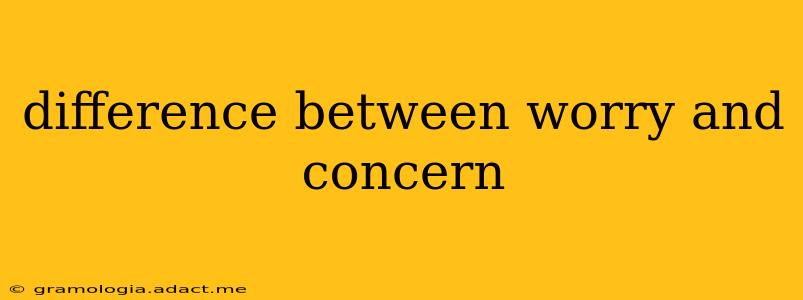The terms "worry" and "concern" are often used interchangeably, but they represent distinct emotional states. While both involve thinking about a potential problem, their nature, intensity, and impact differ significantly. Understanding this difference is crucial for managing anxiety and improving overall well-being.
What is Worry?
Worry is characterized by excessive, persistent, and often unproductive thinking about potential negative outcomes. It's an intense emotional state fueled by fear and apprehension, focusing on the "what ifs" and worst-case scenarios. Worry tends to be repetitive, draining, and ultimately unhelpful in problem-solving. It often involves a feeling of helplessness and a lack of control over the situation.
Key characteristics of worry:
- Intense and overwhelming: Worry consumes mental energy and can be difficult to shake off.
- Future-oriented: It dwells on potential problems that may or may not happen.
- Unproductive: It rarely leads to solutions and often exacerbates anxiety.
- Physiological symptoms: Worry can manifest physically through increased heart rate, muscle tension, difficulty sleeping, and digestive problems.
What is Concern?
Concern, on the other hand, reflects a more measured and constructive response to a potential problem. It involves acknowledging a challenge or risk while maintaining a sense of control and ability to address it. Concern is typically accompanied by a proactive approach, involving planning and problem-solving strategies. It's a more rational and less emotionally charged response compared to worry.
Key characteristics of concern:
- Measured and rational: Concern is a thoughtful assessment of a situation, not an emotional flood.
- Problem-solving focused: It motivates action and the search for solutions.
- Balanced perspective: It acknowledges potential risks while considering the likelihood and impact.
- Constructive engagement: It fosters a sense of agency and empowerment.
What's the difference between anxiety and worry?
While worry is a symptom of anxiety, they are not the same. Anxiety is a broader term encompassing a range of emotional and physical symptoms, including worry, fear, nervousness, and restlessness. Worry is a specific manifestation of anxiety, often characterized by its repetitive and unproductive nature.
How can I tell if I'm worrying too much?
Excessive worrying is a common symptom of anxiety disorders like generalized anxiety disorder (GAD). If your worry is:
- Constant and pervasive: affecting most areas of your life.
- Interfering with daily functioning: impacting your work, relationships, or sleep.
- Accompanied by significant physical symptoms: such as heart palpitations, shortness of breath, or muscle tension.
- Unresponsive to self-help strategies: You've tried relaxation techniques or other coping mechanisms without success.
It's crucial to seek professional help. A therapist or counselor can provide guidance and support to manage your anxiety and develop healthier coping mechanisms.
How can I turn worry into concern?
The transition from worry to concern requires a shift in perspective and approach. Here are some strategies:
- Identify the source of your worry: Clearly define the specific issue causing your anxiety.
- Assess the likelihood and impact: Realistically evaluate the probability of the negative outcome and its potential consequences.
- Develop a plan of action: Create a concrete strategy to address the problem, breaking it down into manageable steps.
- Focus on what you can control: Channel your energy into actions you can take, rather than dwelling on things outside your influence.
- Practice mindfulness and relaxation techniques: Techniques like meditation, deep breathing, and yoga can help calm your mind and reduce anxiety.
By understanding the subtle yet significant differences between worry and concern, you can cultivate a more balanced and productive approach to navigating life's challenges. Remember, seeking professional help is a sign of strength, not weakness, especially if worry is significantly impacting your quality of life.
